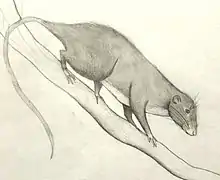| Dactylomys Temporal range: | |
|---|---|
| Scientific classification | |
| Domain: | Eukaryota |
| Kingdom: | Animalia |
| Phylum: | Chordata |
| Class: | Mammalia |
| Order: | Rodentia |
| Family: | Echimyidae |
| Subfamily: | Echimyinae |
| Tribe: | Echimyini |
| Genus: | Dactylomys Saint-Hilaire, 1838 |
| Type species | |
| Dactylomys typus | |
| Species | |
|
Dactylomys boliviensis | |
| Synonyms | |
|
Lachnomys Thomas, 1916 | |

Dactylomys is the genus of South American bamboo rats[1] They are arboreal members of the family Echimyidae.
Systematics
The genus name Dactylomys derives from the two Ancient Greek words δάκτυλος (dáktulos), meaning "finger", and μῦς (mûs), meaning "mouse, rat",[2][3] and refers to the middle two digits especially elongated relative to lateral ones as observed in these rodents.[4]
The genus contains three species:
- Dactylomys boliviensis (Bolivian bamboo rat)
- Dactylomys dactylinus (Amazon bamboo rat)
- Dactylomys peruanus (Montane bamboo rat)
Phylogeny
Dactylomys is a member of the Echimyini clade of arboreal Echimyidae rodents. The closest relative of Dactylomys is Olallamys, and then Kannabateomys. These South American bamboo rats share unique features and are grouped under the informal clade name of "Dactylomyines".[5] The dactylomyines are the sister genera to Diplomys and Santamartamys. All these taxa are closely related to the genera Echimys, Phyllomys, Makalata, Pattonomys, and Toromys. In turn, these genera share phylogenetic affinities with the clade containing Lonchothrix and Mesomys, and with Isothrix.[6]
| Genus-level cladogram of the Echimyini. | |||||||||||||||||||||||||||||||||||||||||||||||||||||||||||||||||||||||||||
| |||||||||||||||||||||||||||||||||||||||||||||||||||||||||||||||||||||||||||
| The cladogram has been reconstructed from mitochondrial and nuclear DNA characters.[7][8][9][10][11][12][13][14][6] |
References
- ↑ Woods, C.A.; Kilpatrick, C.W. (2005). "Genus Dactylomys". In Wilson, D.E.; Reeder, D.M (eds.). Mammal Species of the World: A Taxonomic and Geographic Reference (3rd ed.). Johns Hopkins University Press. p. 1576. ISBN 978-0-8018-8221-0. OCLC 62265494.
- ↑ Bailly, Anatole (1981-01-01). Abrégé du dictionnaire grec français. Paris: Hachette. ISBN 978-2010035289. OCLC 461974285.
- ↑ Bailly, Anatole. "Greek-french dictionary online". www.tabularium.be. Retrieved December 2, 2017.
- ↑ Patton, James L.; Pardiñas, Ulyses F. J.; D’Elía, Guillermo (2015-03-09). Mammals of South America, Volume 2: Rodents. University of Chicago Press. p. 880. ISBN 9780226169576.
- ↑ Fabre, Pierre-Henri; Patton, James L.; Leite, Yuri L. R. (2016). "Family Echimyidae (hutias, South American spiny-rats and coypu)". In Wilson, Don E.; Lacher, Thomas E. Jr; Mittermeier, Russell A. (eds.). Handbook of the Mammals of the World. Vol 6. Lagomorphs and Rodents I. Barcelona: Lynx Edicions. pp. 552–641. ISBN 978-84-941892-3-4.
- 1 2 Fabre, Pierre-Henri; Upham, Nathan S.; Emmons, Louise H.; Justy, Fabienne; Leite, Yuri L. R.; Loss, Ana Carolina; Orlando, Ludovic; Tilak, Marie-Ka; Patterson, Bruce D.; Douzery, Emmanuel J. P. (2017-03-01). "Mitogenomic Phylogeny, Diversification, and Biogeography of South American Spiny Rats". Molecular Biology and Evolution. 34 (3): 613–633. doi:10.1093/molbev/msw261. ISSN 0737-4038. PMID 28025278.
- ↑ Lara, Márcia C.; Patton, James L.; da Silva, Maria Nazareth F. (1996). "The Simultaneous Diversification of South American Echimyid Rodents (Hystricognathi) Based on Complete Cytochrome b Sequences". Molecular Phylogenetics and Evolution. 5 (2): 403–413. doi:10.1006/mpev.1996.0035. PMID 8728398.
- ↑ Leite, Yuri L. R.; Patton, James L. (2002). "Evolution of South American spiny rats (Rodentia, Echimyidae): the star-phylogeny hypothesis revisited". Molecular Phylogenetics and Evolution. 25 (3): 455–464. doi:10.1016/s1055-7903(02)00279-8. PMID 12450750.
- ↑ Galewski, Thomas; Mauffrey, Jean-François; Leite, Yuri L. R.; Patton, James L.; Douzery, Emmanuel J. P. (2005). "Ecomorphological diversification among South American spiny rats (Rodentia; Echimyidae): a phylogenetic and chronological approach". Molecular Phylogenetics and Evolution. 34 (3): 601–615. doi:10.1016/j.ympev.2004.11.015. PMID 15683932.
- ↑ Upham, Nathan S.; Patterson, Bruce D. (2012). "Diversification and biogeography of the Neotropical caviomorph lineage Octodontoidea (Rodentia: Hystricognathi)". Molecular Phylogenetics and Evolution. 63 (2): 417–429. doi:10.1016/j.ympev.2012.01.020. PMID 22327013.
- ↑ Fabre, Pierre-Henri; Galewski, Thomas; Tilak, Marie-ka; Douzery, Emmanuel J. P. (2013-03-01). "Diversification of South American spiny rats (Echimyidae): a multigene phylogenetic approach". Zoologica Scripta. 42 (2): 117–134. doi:10.1111/j.1463-6409.2012.00572.x. ISSN 1463-6409.
- ↑ Loss, Ana; Moura, Raquel T.; Leite, Yuri L. R. (2014). "Unexpected phylogenetic relationships of the painted tree rat Callistomys pictus (Rodentia: Echimyidae)" (PDF). Natureza on Line. 12: 132–136.
- ↑ Fabre, Pierre-Henri; Vilstrup, Julia T.; Raghavan, Maanasa; Der Sarkissian, Clio; Willerslev, Eske; Douzery, Emmanuel J. P.; Orlando, Ludovic (2014-07-01). "Rodents of the Caribbean: origin and diversification of hutias unravelled by next-generation museomics". Biology Letters. 10 (7): 20140266. doi:10.1098/rsbl.2014.0266. ISSN 1744-9561. PMC 4126619. PMID 25115033.
- ↑ Upham, Nathan S.; Patterson, Bruce D. (2015). "Evolution of Caviomorph rodents: a complete phylogeny and timetree for living genera". In Vassallo, Aldo Ivan; Antenucci, Daniel (eds.). Biology of caviomorph rodents: diversity and evolution. Buenos Aires: SAREM Series A, Mammalogical Research — Sociedad Argentina para el Estudio de los Mamíferos. pp. 63–120.